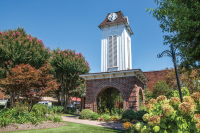The good, the bad and the silver lining
 The Canton paper mill has been an economic anchor in Haywood County since 1908, providing livelihoods for tens of thousands of workers over its proud and storied history.
The Canton paper mill has been an economic anchor in Haywood County since 1908, providing livelihoods for tens of thousands of workers over its proud and storied history.
There’s a dark side to the mill’s century-old legacy, however. The largest factory in the mountains comes with a caveat — it’s also the largest polluter of air and water, according to state permits.
The spewing smoke and black, foamy river are certainly the most telltale signs of the mill’s environmental contamination.
But the mill’s pollution footprint also includes vast landfills laden with toxic sludge and coal ash. The paper mill’s round-the-clock operation means a round-the-clock stream of industrial waste. Trucks run nonstop from the mill to the landfill gates, dumping their loads and fetching another, an endless cycle aptly dubbed the waste stream.
Over the months and years, the landfills would rise like pyramids, climbing one layer at a time, until finally, it couldn’t go any taller and it was time to start over again with a new pile.
Related Items
A functioning landfill is part of the mill’s backbone — as critical as the coal that feeds the boilers or the wood chips that make the paper. Without somewhere to dump the endless procession of coal ash and industrial sludge, the mill wouldn’t last a day.
Today, the mill’s landfill operations use state-of-the-art technology and cutting edge engineering designs to ensure toxic contaminants stay put. But buried bygones of old unlined landfills will be part of the landscape forever, the toxins tucked in tight for the duration if all goes well, but only time to tell.
The landfills have resculpted the terrain along a 2-mile stretch of the Pigeon River west of Canton, where four large landfills used from the 1960s were sited on tracts flanking the banks. Little can be done on top of them, but therein lies a silver lining.
Former paper mill landfills have been an asset to the community, housing a shooting range for Canton town police officers, a solar energy farm, the headquarters for a model aeroplane club and a regional livestock market and auction serving all of Western North Carolina.
Canton has built a major recreation complex on top of one of International Paper’s old landfills, including ballfields, a batting cage, a concession stand and a walking or crosscountry track.
“It has been a great situation between the town and International Paper, with them letting us develop that site for not only Canton but all of Western North Carolina,” said Canton Mayor Mike Rey. “It has been quite an offering for our community to be able to do that.”
The mill’s landfill isn’t just home to its own waste. Sludge from the mill’s sewage treatment plant, mostly a slurry of industrial byproducts, are dumped in the landfill. But the mill also handles the town’s wastewater. The sewage from all of Canton’s residents go through the mill’s treatment plant, and while small in comparison to the mill’s own volume, it is in the mix of sludge trucked into the landfills.
There’s another side effect from the old dumping sites. They provide a modicum of open space along the growing residential corridor between Canton and Clyde — and to at least one landfill neighbor, it makes for a peaceful view.
Ken Cole loves where he lives — a large house on a knoll overlooking the terraced tops of one of the larger old, unlined landfills.
What’s below the ground doesn’t bother him. In fact, the landfill technically belongs to Cole. Cole’s father leased 70 acres to International Paper in the late 1970s to use as a landfill site, making $700 a month for the seven years it was in operation, according to state files. Although the landfill tract is in Cole’s name, International Paper is the one legally on the hook for any future issues that arise.
Cole doesn’t see a wasteland when he looks out at the fields of freshly cut hay, or his pet guinea hens strutting among a plot of feed corn being grown for silage on top of the landfill.
Turkey and deer are common, along with coyotes. And Cole’s had three bears at different times over the past few years. The river wraps around his property, although the landfill is built up so high, and the river so low in comparison, you can’t actually see it without walking out to the edge of the terraces and looking down.
To Cole, it’s a slice of heaven.
“I tell people I live out in the country, but I’m just two-and-a-half miles from town,” Cole said.









